Don't wanna be here? Send us removal request.
Text
Major Study: Digital Media Art
Assets Used to complete this Project
In order to elevate the visual quality of my scene and enhance its photorealism, I integrated a carefully curated selection of assets sourced from both the Epic Games Marketplace and Quixel Bridge. By leveraging the diverse range of options available on these platforms, I was able to craft an environment that captivated the viewer through its attention to detail and realism. The assets obtained from these resources not only enriched the visual appeal of the scene but also allowed me to achieve a level of perfection that truly elevated the overall aesthetic. By combining elements from the Epic Games Marketplace and Quixel Bridge, the scene was transformed into a stunningly detailed and immersive digital creation that surpassed my initial expectations.
Megascans Trees: European Black Alder (early access)
Construction Site VOL. 1 - Supply and Material Props
Automotive Materials
Industry Props Pack 6
Modular Building set
Megascans Tropical
Megascans Forest Path
Landscape Backgrounds
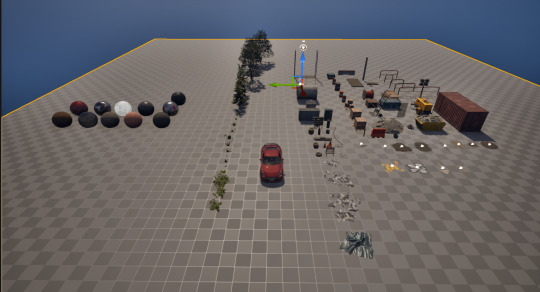
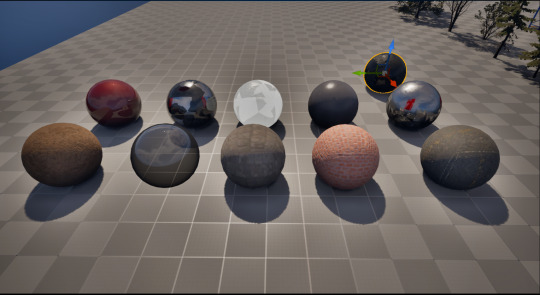
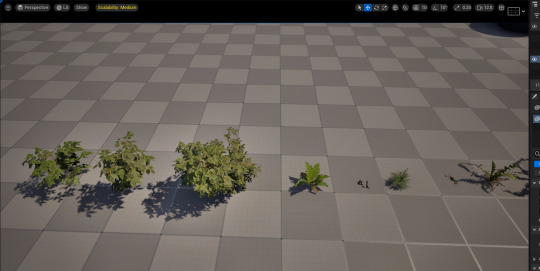
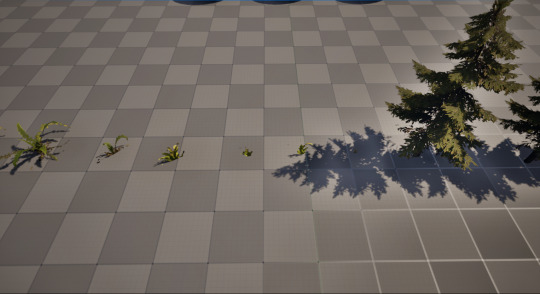

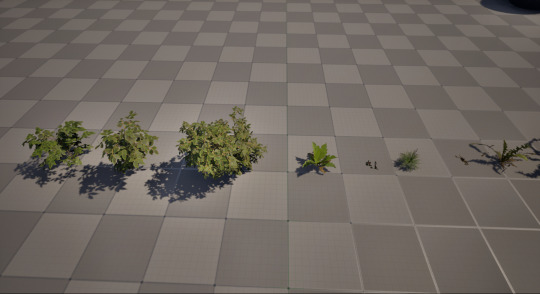
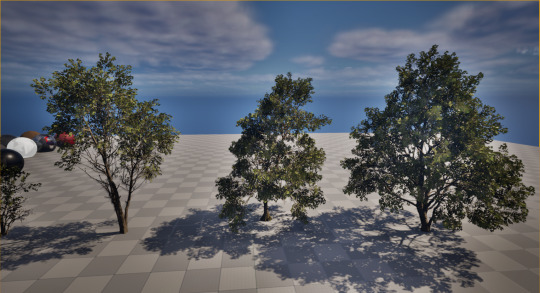
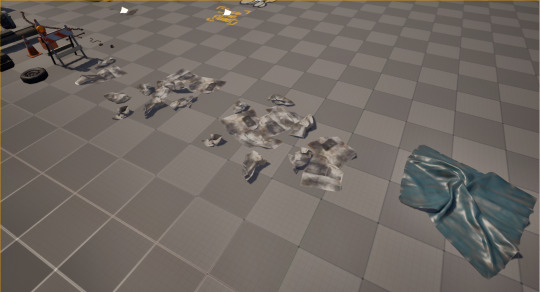
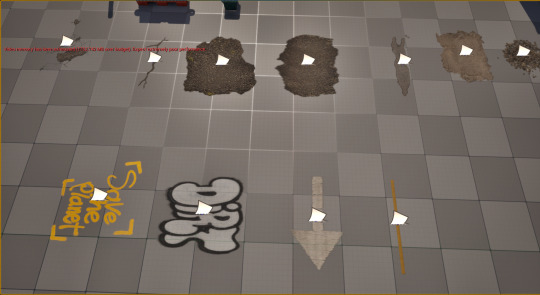
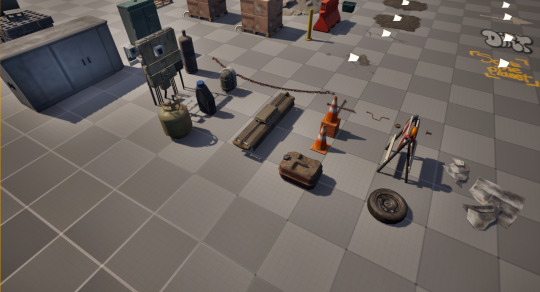
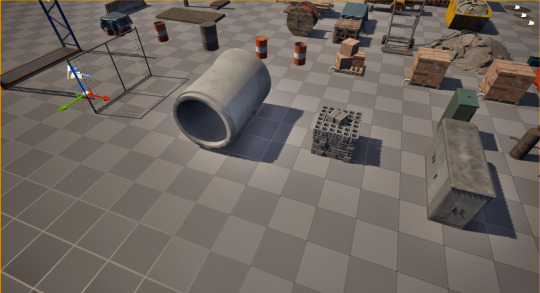
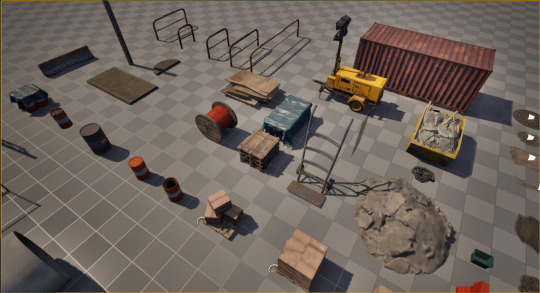
0 notes
Text
Major Study: Digital Media Art
Balancing both performance and intricate detail is crucial when reflecting on ways to optimize the visual quality of a high-detail scene.
When embarking on my 3D art project, a pivotal challenge that arises is the delicate balancing act between upholding meticulous detail levels and guaranteeing smooth performance across the board. This challenge is magnified in intricate undertakings that necessitate a harmonious blend of visual intricacy and real-time user engagement, such as those encountered within the domain of Unreal Engine. In my recent endeavor, which revolved around crafting a meticulously detailed milieu for the Nissan GTR 35, I found myself navigating this fine line with great care and deliberation. Throughout this blog post, I aim to delve deep into the hurdles faced during the optimization of performance, shedding light on the creative compromises I had to make while also reflecting on the novel optimization strategies I acquired throughout this transformative journey.
The Challenge of High-Detail Environments
During the course of executing the GTR 35 project, the primary objective was to sculpt a visually captivating, hyper-realistic backdrop that would seamlessly complement the sleek contours of the car's design. This endeavor involved the integration of elaborate assets, intricate textures, and sophisticated lighting schemes. However, as the complexity of the scene escalated, a myriad of performance stumbling blocks emerged, notably in the form of fluctuating frame rates and extended rendering durations. The proliferation of high-poly models, elaborate textures, and intricate foliage elements collectively bore down on the scene, challenging the real-time rendering capacity of Unreal Engine. This conundrum underscored the need to uphold the scene's visual opulence while concurrently ensuring its seamless operability, particularly during dynamic animation sequences.
Creative Trade-Offs for Performance Optimization
In order to counter these obstructions, a host of creative trade-offs had to be meticulously weighed and enacted. An initial step undertaken was the strategic optimization of asset polygon counts. While high-poly models do exude a compelling allure up close, their presence in real-time applications can exact a heavy toll on performance efficiency. Leveraging Blender's Decimate modifier, I judiciously curtailed the polygon count on superfluous environmental components. For assets occupying a distant vantage point, low-poly iterations were sculpted to supplant their high-poly equivalents, ensuring minimal visual disparity when viewed from the camera's standpoint.
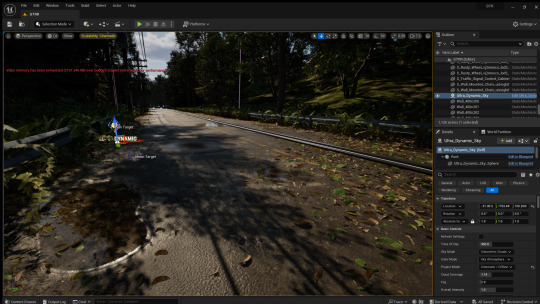
Another pivotal trade-off entailed the incorporation of Level of Detail (LOD) settings. By embracing LODs, I empowered Unreal Engine to seamlessly transition to lower-detail renditions of models as their proximity to the camera waxed distant. This dynamic shift significantly curbed the polygon load at any given instance, augmenting performance sans compromising the visual richness of the scene. A judicious management of LOD transitions was adopted to avert perceptible "popping" effects that could disrupt the audience's immersive engagement.

Textures emerged as yet another frontier necessitating trade-offs. Though high-resolution textures can markedly amplify a scene's realism, they concurrently engross a substantial chunk of memory and processing resources. I opted for lower-resolution textures for peripheral objects, while reserving top-tier textures for the car and other focal elements. Furthermore, the strategic deployment of texture streaming in Unreal Engine facilitated the dynamic allocation of textures based on their proximity to the camera, thereby optimizing memory consumption and enhancing performance efficiency.
0 notes
Text
Major Study: Digital Media Art
Exploring the captivating influence of majestic mountains on the perception of scene depth in photorealistic backgrounds.
In the realm of 3D visualization, the key to crafting a truly immersive and engaging scene often lies in the ability to imbue it with depth and a sense of realism. This contrast between a static, lifeless image and one that captivates lies in the background elements, particularly in the case of vast, natural features such as mountains, which play a pivotal role in achieving this desired depth. Reflecting on a recent project involving the rendering of a Nissan GTR 35 in a realistic environment, the decision to incorporate photorealistic mountains as a backdrop emerges as a critical aspect worth exploring. This introspective piece delves into the thought process behind opting for these specific elements, dissecting how they contributed to elevating the overall depth and realism of the scene, as well as imparting valuable insights into the seamless integration of such large-scale natural components in a 3D setup.
In the initial phase of conceptualizing the environment for the GTR 35 project, the quest was not merely for a perfunctory backdrop but rather for an intrinsic element that would enhance the visual impact of the car. The deliberate selection of photorealistic mountains stemmed from a desire to not just create a setting but to evoke a profound sense of scale and grandeur. Mountains, with their innate majesty and textured intricacies, possess the ability to infuse a scene with captivating visual allure, effectively framing the subject and channeling the viewer's attention.
Within the context of automotive depiction, juxtaposing a high-performance vehicle like the GTR 35 against the backdrop of towering mountains serves to forge a compelling visual dichotomy. The marriage of the car's sleek, contemporary design with the enduring, natural forms of the mountains serves to accentuate the vehicle's aesthetics, resulting in a striking visual spectacle that not only highlights the car but also embeds it within a context that is both believable and immersive.
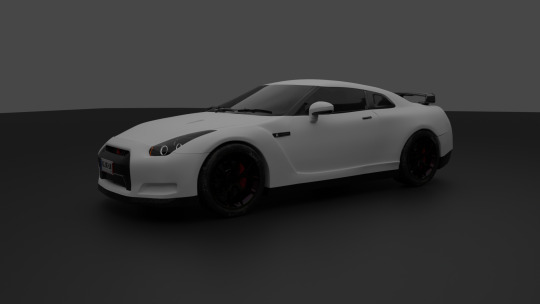
The integration of photorealistic mountains in the background achieves an immediate elevation in the scene's spatial dynamics and realism. The inherent quality of mountains to recede into the distance naturally bestows the scene with an enhanced sense of depth, creating a gradient of detail and light that draws the viewer deeper into the composition. This layer of depth is instrumental in preventing the scene from appearing flat or lackluster.
To achieve this heightened sense of depth, a meticulous process of selecting a sophisticated photorealistic mountain asset was embarked upon, with a focus on ensuring a balance between high detail levels for up-close inspection and appropriate scale for distant believability. Through meticulous adjustments within Unreal Engine, the mountain range was strategically positioned at a distance, whereby scale and orientation were fine-tuned to foster an illusion of an expansive and panoramic landscape that seamlessly extended beyond the immediate vicinity.
Noteworthy in enhancing the realism of the mountains was the pivotal role of lighting. Ensuring that the light direction and intensity aligned with the rest of the scene led to the creation of consistent shadows and highlights that spanned both the car and the mountains. This synchronization lent an air of coherence to the mountains within the scene, blurring the distinction between them and the environment, hence grounding them as an organic extension rather than a detached entity within the setup.
0 notes
Text
Major Study: Digital Media Art
Transitioning smoothly from Blender to Unreal Engine, our goal is to enhance efficiency in the workflow process.
Transitioning a project from modeling in Blender to rendering in Unreal Engine can be a highly intricate and complex process that demands meticulous planning, precise execution, and unwavering attention to detail. In my recent and engagingly challenging endeavor centered around the Nissan GTR 35, I had the invaluable opportunity to thoroughly explore and immerse myself in this intricate workflow, uncovering a myriad of insightful perspectives and refining my skills.
Delving deep into the intricacies of this transition, I embarked on a journey rife with challenges that demanded innovative solutions and strategic problem-solving. The art of maintaining the model's integrity during the export-import phase emerged as a prominent hurdle, as bridging the disparity between Blender and Unreal Engine's distinct file formats and coordinate systems necessitated careful navigation to thwart issues such as scaling discrepancies, flipped normals, and misaligned UV maps. Addressing these hurdles head-on not only required perseverance but also added an extra layer of complexity to the already intricate process.
Moreover, the task of optimizing the model for real-time rendering posed another set of challenges that demanded a delicate balance between intricate detail and optimal performance. The transition from Blender's penchant for high-poly models to Unreal Engine's demand for optimized assets precipitated careful considerations regarding polygon count, LOD settings, and texture resolutions. This intricate dance between maintaining visual fidelity and ensuring optimal performance engendered a meticulous approach to the project’s design and development.
In response to these challenges, a repertoire of creative solutions was crafted to streamline the workflow and enhance efficiency. Establishing a structured pipeline for asset export and import emerged as a pivotal strategy, where the utilization of the FBX file format and meticulous calibration of model scaling were instrumental in mitigating potential import issues. Proactively addressing concerns like flipped normals and misaligned UV maps through careful validation and Blender tools streamlined the transition process, mitigating unnecessary troubleshooting and time-consuming adjustments.
Furthermore, the pivotal step of optimizing the model for real-time rendering underscored the necessity of striking a delicate balance between visual fidelity and performance. Leveraging tools like the Decimate modifier in Blender enabled meticulous polygon reduction while preserving essential details, and the creation of multiple LOD versions ensured adaptive levels of detail to enhance performance in complex scenes. Additionally, the strategic use of Substance Painter in tandem with Blender facilitated the creation of high-quality textures optimized for Unreal Engine, further enriching the visual appeal of the final render.
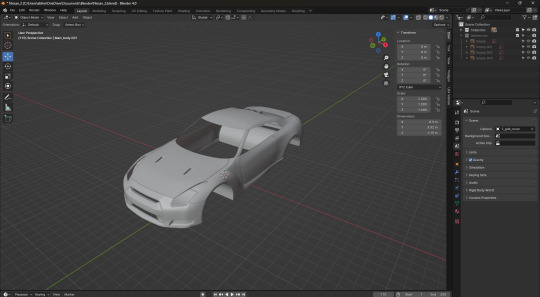
As the project unfolded, invaluable lessons were gleaned, emphasizing the significance of thorough preparation, methodical iteration, and the immersive capabilities of real-time rendering in Unreal Engine. By meticulously honing my workflow, navigating intricate challenges with creative solutions, and embracing the power of iterative testing, I not only transcended the complexities of transitioning from Blender to Unreal Engine but also cultivated a profound appreciation for the depth and immersive realism achievable through real-time rendering.
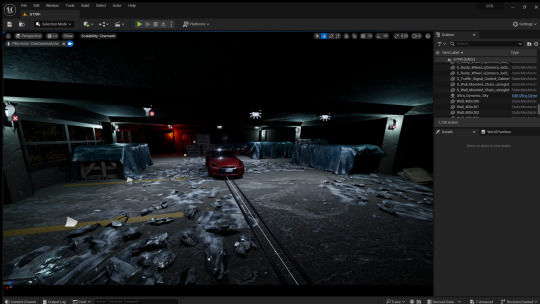
In conclusion, the transformative journey from Blender modeling to Unreal Engine rendering embodies a profound learning experience characterized by resilience, creativity, and a relentless pursuit of excellence in 3D visualization. The culmination of overcoming challenges, optimizing workflows, and achieving professional-grade results underscores the significance of meticulous planning, dedication to craft, and the profound impact of well-executed workflow strategies in the realm of 3D visualization.
0 notes
Text
Major Study: Digital Media Art
Lighting: A Key to Realistic Design
Lighting in automotive visualization is not just about illuminating the scene; it is about defining the very essence of the vehicle itself. The Nissan GTR 35, with its sleek curves and bold presence, called for lighting that would not only showcase its design but also evoke a feeling of power and speed. By carefully sculpting the light to accentuate every surface, from the flawless paint to the intricate tire textures, I aimed to reveal the GTR 35 in a manner that highlighted its every detail while infusing it with life and energy.
In this particular project, my focus was on striking a delicate balance between realism and artistic flair through lighting. My intention was to present the GTR 35 in a setup that appeared as if it belonged in a tangible, real-world scenario, all the while injecting a sense of drama and intensity into the visualization. Achieving this equilibrium demanded meticulous planning regarding the placement of light sources, their characteristics, and how they interacted not only with the vehicle but also with the surrounding environment.
The initial phase of lighting this scene involved making crucial creative decisions to establish the desired mood and ambiance. Envisioning a scenario that would accentuate the car's sharp lines and commanding profile, I experimented within Unreal Engine by starting with a traditional three-point lighting setup encompassing a key light, fill light, and rim light arrangement.
The key light, as the predominant source of brightness, was strategically positioned to emulate natural sunlight, casting distinct, directional shadows across the GTR 35 and enhancing the reflective qualities of its metallic paint. By doing so, the light helped shape the car's structure, adding dynamism to the overall appearance. To soften these shadows and introduce depth, I incorporated a cooler fill light on the opposite side of the key light, ensuring that darker regions of the vehicle remained visible without being overshadowed.
The addition of a rim light behind the car played a critical role in delineating the GTR 35 from its background, creating a subtle halo effect that heightened the sense of depth and ensured its prominent presence within the scene. Furthermore, blending environmental lighting, specifically a high-dynamic-range image (HDRI) of a racetrack background, with artificial lights contributed not only to the realism of the visualization but also to the integration of the vehicle into its surrounding context, forging a cohesive visual narrative.
Throughout this project, I uncovered various techniques that enriched my understanding of effective lighting in the realm of automotive visualization. Experimenting with different light configurations was instrumental in discovering the optimal setup for a particular scene, underscoring the significant influence of light source intensity, color variations, and directional angles on the final impact of the render. Embracing the role of light reflections, as explored in Unreal Engine through diverse reflection capture methods, proved pivotal in enhancing the authenticity and coherence of the GTR 35's reflective surfaces, particularly crucial for the glossy paint finish.
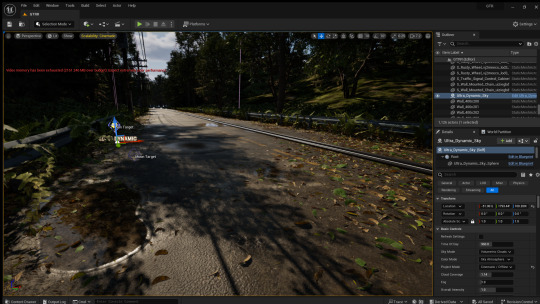
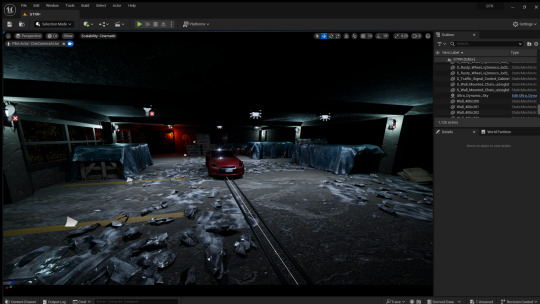
Moreover, delving into post-processing procedures within Unreal Engine unveiled the importance of refining the render's final look. Adjusting exposure, contrast levels, and color grading via post-processing tools allowed for fine-tuning and enhancement of the created lighting effects, culminating in a meticulously polished and visually captivating result that showcased the Nissan GTR 35 in its full glory.
0 notes
Text
Major Study: Digital Media Art
Exploring the integration of industrial elements involves finding the delicate equilibrium between enhancing realism and prioritizing aesthetic appeal.
In the realm of 3D environment creation, the meticulous selection and strategic placement of assets play a pivotal role in shaping the immersive experience of a scene. Specifically focusing on my recent project centered around the Nissan GTR 35, a significant challenge that arose was the effective integration of industrial components within the garage space, aiming to amplify the scene's authenticity while preserving its aesthetic allure. This blog entry will delve into the intricate creative decisions I encountered during this process, the delicate equilibrium I aimed to strike between authenticity and visual appeal, as well as the invaluable insights gleaned from curating harmonious and cohesive environments.
Exploring the Significance of Industrial Elements in the Scene Industrial elements assume a fundamental role in establishing the ambiance and narrative of a 3D environment, acting as essential building blocks for portraying a rich, detailed setting. Amidst my project scope, the garage emerged as a critical location where the Nissan GTR 35 embarks on its journey, underscoring the necessity of infusing the space with industrial assets that seamlessly blend into a high-performance automotive environment. Instruments such as meticulously chosen tool racks, strategically placed oil drums, thoughtfully scattered crates, and carefully positioned machinery were instrumental in fleshing out the scene, fostering a sense of practicality and lived-in vibrancy.
These industrial components were not mere props but rather narrative threads woven with intent. The presence of top-tier industrial apparatus not only conveys the technical prowess and precision crucial for maintaining the GTR 35 but also hints at the ongoing meticulous work and dynamic ethos enveloping the space. Opting for these specific assets aimed to establish a garage that exudes authenticity and functionality, mirroring the elevated standards characteristic of automotive engineering environments.
Striking a Fine Balance Between Realism and Aesthetic Allure A primary hurdle encountered in integrating industrial elements lay in harmonizing the demands of realism with those of visual appeal. Striking a delicate equilibrium entailed ensuring that the chosen assets not only felt organic and fitting within the context but also contributed to enhancing the scene's visual impact without overshadowing or cluttering the space.
To navigate this intricate balance, I initiated by meticulously analyzing the garage layout. The positioning of industrial assets followed a logical trajectory inspired by real-world scenarios: tool storage units found their place adjacent to workstations, oil drums occupied unobtrusive yet accessible corners, and machinery was strategically aligned to suggest an operational and efficient workflow. This strategic approach guaranteed that the environment emanated a natural and functional essence.
Nonetheless, realism alone failed to suffice. I had to factor in how these elements integrated into the scene's overall composition. Leveraging the color palettes and textures of the industrial assets served to create visual juxtapositions, guiding the viewer's gaze towards focal points such as the vehicle or the garage entrance. By juxtaposing weathered metal barrels and timeworn tool chests against sleek, polished surfaces, I crafted a visual interplay that juxtaposed the rugged with the refined.
0 notes
Text
Major Study: Digital Media Art
Exploring the process of animating the GTR 35 through a detailed journey showcasing innovative camera rail rigging techniques.
Expanded Content: Throughout the process of animating the Nissan GTR 35 in Unreal Engine using the camera rail rig, I explored a holistic approach to capture the essence and nuances of the car's power, speed, and agility beyond mere point-to-point movement. The project encapsulated an immersive journey that delved into the intricacies of vehicle animation, emphasizing the seamless fusion of technical precision and creative vision.
As I delved into the intricacies of animating such an iconic car, especially with a focus on the GTR 35's unmistakable characteristics, my aim was to transcend the realm of animation and invoke a sense of realism that mirrored a tangible driving experience. This quest for authenticity required a meticulous understanding of the car's dynamics and behavior, coupled with a comprehensive utilization of the animation tools available within Unreal Engine.
The application of the camera rail rig in Unreal Engine emerged as a guiding force in my animation process, enabling me to orchestrate a symphony of motion that exuded both dynamism and narrative depth. By sculpting the camera movements along the rail system, I was empowered to curate a visual tapestry that visually narrated the GTR 35's journey with finesse and artistry.
The intricate dance between realism and visual appeal posed a significant challenge during the animation process, prompting me to harmonize the technical accuracy of physics simulation with the subjective perception of captivating motion. This equilibrium demanded a delicate interplay of manual adjustments to fine-tune the car's trajectory along the rail rig, ensuring a harmonious merger of physics-driven movement and visually compelling aesthetics.
Synchronizing the car's motion with the camera angles emerged as another frontier in my animation odyssey, demanding an astute balance between showcasing the car's prowess and maintaining narrative coherence throughout the visual narrative. The judicious choreography of camera perspectives and motion dynamics was paramount in ensuring a seamless alignment between the car's performance and the viewer's engagement.
Throughout this immersive voyage of animating the GTR 35, I gleaned invaluable insights that underscored the pivotal role of meticulous planning and creative ideation in crafting a compelling visual narrative. Embracing the art of exaggeration to accentuate the car's dynamic presence and leveraging the camera rail rig as a storytelling tool not only enriched the animation process but also broadened my conceptual horizon on automotive visualization.
In conclusion, the transformative journey of animating the Nissan GTR 35 unraveled a tapestry of technical prowess and creative ingenuity, illustrating the fusion of innovation and artistry in bringing mechanical marvels to life through animation. The synthesis of technical acumen with artistic expression not only elevated the visual storytelling but also deepened my appreciation for the seamless integration of technology and creativity in the realm of automotive visualization.
0 notes
Text
Major Study: Digital Media Art
Exploring the intricate process involved in constructing a lifelike track through the delicate techniques of mesh painting and intricate decal placements.
In automotive visualization, the track is more than just a surface for the vehicle to move on; it’s a key element that sets the tone of the entire scene. A well-detailed track can enhance the realism of the environment, making the viewer feel as though the car is interacting with a real-world surface. From the texture of the asphalt to the wear and tear visible on the track, every detail contributes to the authenticity of the scene. For this project, I aimed to create a track that looked as though it had seen plenty of action—complete with skid marks, cracks, puddles, and other signs of wear. The meticulous attention to detail required to achieve this level of realism cannot be understated; it involves carefully considering how each imperfection and variation in the track's surface contributes to the overall narrative of the scene. By focusing on elements like the distribution of skid marks and the placement of cracks, I aimed to tell a story of intense racing activity and the passage of time on the track. This deliberate approach not only adds visual interest but also builds a sense of history and character into the environment.
Furthermore, by exploring the creative decisions and technical intricacies behind mesh painting in Unreal Engine, I delved into a world of endless possibilities for adding depth and variety to the track environment. Mesh painting emerged as a powerful tool, enabling me to introduce subtle changes in the asphalt’s texture and create a visually dynamic track that felt alive. The learning curve associated with mesh painting, particularly in mastering the control of material blending and understanding the nuances of texture application, proved to be a valuable journey of experimentation and refinement. Overcoming these challenges required a balance of artistic vision and technical proficiency, as each brushstroke and adjustment played a crucial role in shaping the track's realism and vibrancy.
The utilization of decals further enriched the track environment, bringing it to life with intricate details like skid marks, cracks, and debris. These elements not only added authenticity but also served as storytelling devices, conveying the track's history and usage over time. Through strategic placement and meticulous texturing, I was able to infuse the track with a sense of dynamic energy and weathered charm, evoking a narrative of past races and high-speed excitement. The process of integrating decals into the scene involved a meticulous approach, requiring me to consider the track's topography, lighting conditions, and the trajectory of the car to ensure that each element blended seamlessly with the environment.
In conclusion, the journey of creating a realistic track in a 3D environment is a multifaceted one that demands a harmonious blend of technical prowess, creative vision, and unwavering attention to detail. By weaving together the art of mesh painting and the storytelling capabilities of decals in Unreal Engine, I was able to sculpt a track that transcended being just a backdrop and became a living, breathing element within the scene. The process of refining textures, balancing materials, and infusing narrative elements into the environment was not just a technical endeavor, but a narrative journey that deepened my understanding of how each visual element contributes to the overall storytelling experience.
0 notes
Text
Major Study: Digital Media Art
Learn valuable techniques on how to use Substance Painter to enhance realism through texturing in this insightful lesson.
Texturing plays a critical role in achieving realism in automotive visualization, where the ultimate aim is to craft a model that not only mirrors the real vehicle’s appearance but also mimics its behavior under varied lighting conditions and surroundings. It is the process of applying materials and intricate details that finalize the model's aesthetics. When it comes to the Nissan GTR 35, replicating its iconic metallic paint, detailed interior, and diverse surface imperfections becomes paramount in breathing life into the model.
Commencing the texturing journey of the Nissan GTR 35 involved an extensive collection of reference images to deeply grasp the nuances of the car's paint job, tire textures, and interior components. Armed with these references, the initial step was to outline the primary materials within Substance Painter.
The first focal point was the exterior paint of the GTR 35, which boasts a sophisticated, multi-layered coating comprising a base coat, metallic layer, and clear coat. To mirror this in Substance Painter, a stratified approach was adopted by creating multiple layers within the material stack, each representing a distinct component of the paint. This layering technique facilitated precise adjustments in reflectivity, roughness, and metallic attributes, guaranteeing a realistic response of the paint under diverse lighting conditions.
In the case of the tires and other rubber elements, the procedural texturing abilities of Substance Painter were harnessed to achieve a worn, slightly dirty appearance. This not only introduced a touch of authenticity by simulating a driven vehicle but also enhanced the overall realism. Similarly, leveraging procedural materials and manual painting techniques, the brake calipers and other metallic parts were textured to emphasize areas of wear and tear.
Among the challenges faced during the texturing process, striking the right equilibrium between realism and visual appeal emerged as a significant hurdle. The textures must not only appear realistic but also enhance the model's visual impact. This was particularly evident in dealing with the car's paint, where a fine line had to be walked between excessive roughness leading to a dull appearance and excessive gloss imparting an artificial look.
Moreover, maintaining consistency across different sections of the model posed another challenge. Ensuring that the dirt level on the tires matched the wear on the brake discs or the subtle scratches on the car's body demanded meticulous attention to detail and extensive fine-tuning. The iterative process of switching between Substance Painter and reference images became a norm, allowing for minor tweaks until a coherent look was achieved.
Discovering new techniques proved invaluable throughout the texturing journey. Anchor points in Substance Painter emerged as a game-changer, facilitating the incorporation of details from one layer into another, enabling the creation of intricate, layered effects such as dirt accumulation in crevices or paint chipping along the car's panels' edges. Embracing the smart materials and masks within Substance Painter also significantly streamlined the process, automating the application of realistic wear and tear based on the model's geometry. This saved time while maintaining a high level of precision across the model.
One key takeaway was the importance of working iteratively: constantly switching between Substance Painter and the final rendering environment ensured that the textures not only stood alone but also integrated seamlessly within the overall scene, promoting a harmonious composition.
0 notes
Text
Major Study: Digital Media Art
Mastering the Nissan GTR 35: Overcoming Challenges with Creative Solutions
Modeling a car like the Nissan GTR 35 in Blender is a multi-faceted task that necessitates a combination of precision, patience, and creativity. The GTR 35 is widely renowned for its iconic design and intricate details, which bring about a set of unique challenges for any 3D artist venturing to recreate it in a digital environment. Throughout this blog, I will delve into a comprehensive breakdown of the hurdles faced during the modeling process, the innovative decisions that were made to encapsulate the car’s essence, and elaborate on the various techniques and tools that were instrumental in refining the overall approach to this intricate project.
The Complexity of the Nissan GTR 35 is truly remarkable, with its sophisticated geometry and distinctive features setting it apart in the automotive world. From the elegant curves of the body to the fierce front fascia and intricate wheel designs, each aspect demands meticulous attention to detail. Converting these real-world intricacies into a digital model not only requires accuracy in appearance but also demands that it behaves realistically when rendered or animated.
The first significant challenge encountered was capturing the precise curves and contours of the GTR, a task that required a profound understanding of edge flow and topology within Blender. To ensure accuracy, reference images and blueprints played a crucial role in guiding the initial blocking out of the car's form, gradually refining the mesh to mirror the authentic contours. Maintaining clean edge loops was paramount in achieving seamless transitions between surfaces whilst avoiding unwanted artifacts or distortions.
Transitioning to detailing the Front Fascia and Grille, additional hurdles were met in modeling the distinctive elements, such as the intricate grille and aggressive air intakes. The complex patterns and intricacies necessitated strategic planning. Techniques like Blender’s array and mirror modifiers proved invaluable, enabling efficient replication of repetitive patterns and ensuring consistency across the model. The mirror modifier streamlined the process for symmetrical parts like the air intakes, allowing focused work on one side with automatic updates on the other.
Moving forward, realistic representation of the Wheels and Tires posed a fresh challenge, given their significance to the GTR 35’s performance-oriented design. Detailed attention was required for the rims, tires, and brake calipers, emphasizing the importance of modularity in modeling complex components. Breaking down intricate elements into manageable pieces facilitated the maintenance of high detail levels without overwhelming the workflow.
Throughout the modeling journey, creative solutions were employed to navigate obstacles. The utilization of Blender's shrinkwrap modifier enabled the projection of intricate details like emblems and badges onto the model surface without distorting the underlying geometry. Furthermore, experimentation with various shading techniques allowed for a preview of the textured model’s final look, helping identify areas needing refinement for a seamless transition to texturing in Substance Painter and rendering in Unreal Engine.
In conclusion, the experience of modeling the Nissan GTR 35 in Blender proved a challenging yet rewarding endeavor that expanded my skill set significantly. Addressing the intricate designs head-on, and applying creative solutions, facilitated the successful capture of the GTR 35’s essence in the digital realm. Key learnings, from managing edge flow to utilizing modifiers effectively, not only optimized the modeling workflow but also enhanced comprehension of the nuances involved in transforming complex real-world objects into compelling 3D representations.
0 notes
Text
Major Study: Digital Media Art
Choosing the Right Vegetation Assets for Optimal Aesthetics and Functionality
I got to know that in the realm of 3D environment creation, the selection of assets holds immense significance as it profoundly influences the ambiance and authenticity of a scene. For a specialized 3D artist concentrating on automotive visualization, the intricate task of harmonizing natural elements, such as vegetation, with artificial structures requires finesse and attention to detail. This reflective blog delves into the meticulous decision-making process behind the choice of specific vegetation assets, namely black alder and elements from the MS_Forest Tut collection, shedding light on how these selections shaped not only the visual appeal but also the functionality and seamless fusion of nature within an industrial backdrop.
Expanding on the Vital Role of Vegetation in 3D Environments: The presence of vegetation in a 3D setting transcends mere decoration, serving as a pivotal element that injects vitality, dimension, and realism into the digital world. In the context of my project, spotlighting a Nissan GTR 35 as it navigates a lifelike environment, integrating natural components stood as a cornerstone for anchoring the scene in verisimilitude. The challenge, then, lay in identifying vegetation that not only mirrored reality but also complemented the overarching design ethos of the environment.
Elaborating on the Selection Process of Black Alder and MS_Forest Tut Assets: The deliberate choice of incorporating black alder and elements from the MS_Forest Tut package stemmed from a vision of striking a delicate equilibrium between the rugged, unrefined allure of nature and the regulated, structured landscapes of tracks and garages. Black alder, noted for its versatility and widespread occurrence in various landscapes, emerged as a versatile candidate adaptable to various scene locations, ranging from track peripheries to background scenery near the garage. The intricate textures and innate shapes of black alder infused a genuine, lived-in feel into the environment, infusing an organic essence to the scene.
On the other hand, the inclusion of assets from MS_Forest Tut introduced a meticulously curated assortment of forest elements that not only framed the environment but also added layers of depth. The lush foliage, intricate undergrowth, and diverse plant species encapsulated within this asset pack facilitated the creation of a nuanced and multi-dimensional setting. These elements proved instrumental in orchestrating a seamless transition from the open road to the surrounding industrial zones near the garage, intertwining the realms of man-made constructions and organic biodiversity seamlessly.
Reflecting on the Impact of Vegetation Selection on the Project's Atmosphere: The flora varieties chosen exercised a pronounced influence on the overall ambiance of the undertaking. The towering black alder trees, with their slender trunks and dense canopies, instilled a sense of enclosure, guiding the observer's focus towards the vehicle and the track while preserving the automotive allure of the scene against a backdrop of natural splendor. Concomitantly, the vegetation sourced from MS_Forest Tut contributed to an immersive experience by supplying a textured backdrop that elevated the sensation of velocity and dynamism as the vehicle traversed the track path. The diverse plant species and thoughtfully orchestrated placements further elevated the realism of the scene, forging a palpable connection between the track and the surrounding forested landscape.
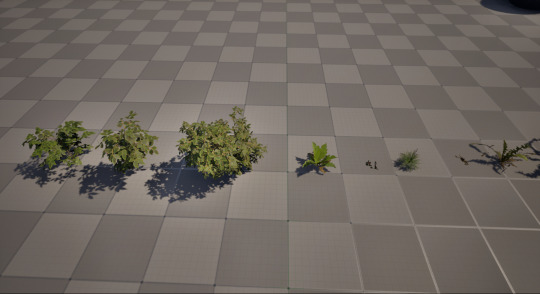
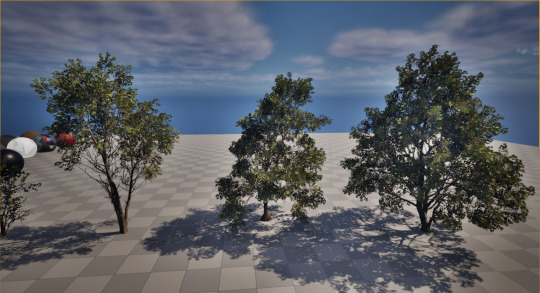
0 notes
Text
Major Study: Digital Media Art
The Evolution of Automotive Materials explores the intricacies of texturing techniques to achieve a heightened sense of realism in the design process.
The remarkable advancements in the field of 3D automotive visualization have been evident over the years, notably in the domain of materials and texturing. As 3D artists constantly endeavor to achieve photorealism in their creations, the tools and techniques available in software like Substance Painter and Unreal Engine have undergone significant developments, offering a diverse array of materials and shaders that work cohesively to bring virtual vehicles remarkably close to reality.
In the early stages of 3D artistry, the depiction of automotive materials was relatively basic, lacking the intricate details necessary to truly emulate realism. The rudimentary shaders used back then could only provide a simplistic representation of metallic surfaces, paint finishes, and glass textures, often failing to capture the subtle nuances that make real-world vehicles aesthetically captivating. However, as the demand for more authentically rendered content increased, so did the necessity for advanced texturing methods and more sophisticated material applications.
Substance Painter has truly revolutionized the art of texturing for 3D artists, especially those working on automotive projects, by offering a vast library of materials meticulously tailored for vehicle designs. Whether it's the creation of glossy car paint with multiple layers of clear coat and base color or the meticulous detailing of metal surfaces with varying roughness levels and reflectivity properties, Substance Painter equips artists with the necessary tools to achieve an unparalleled level of detailing and realism in their work.
A standout feature of Substance Painter is its capability to create intricate material layers. This means that artists can now simulate the gradual wear and tear on a vehicle's paint finish, incorporating subtle scratches, accumulated dirt, and even the effects of environmental exposure and weathering. Such layering functionality empowers artists to establish a deeper, more authentic portrayal of automotive surfaces, significantly elevating the overall realism and visual impact of the final rendered scenes.
0 notes
Text
Major Study: Digital Media Art
In order to enhance the performance of high-detail 3D scenes, it is essential to implement various tips and tricks that can optimize the overall output.
Optimizing performance in high-detail 3D scenes in Unreal Engine involves striking a delicate balance between preserving visual quality and ensuring seamless playback. Successful execution of this balance requires a comprehensive approach that encompasses various optimization strategies to enhance the overall efficiency of the rendering process.
One fundamental aspect to consider is the meticulous management of Level of Detail (LOD) settings. By creating different versions of 3D models tailored to differing complexity levels, you can significantly reduce the computational load when objects are viewed from a distance within the scene. This strategic implementation of LOD can yield substantial performance improvements, especially in expansive virtual environments where numerous assets coexist.
Furthermore, the judicious utilization of textures plays a pivotal role in mitigating performance limitations posed by intricate scenes. Texture atlases emerge as a valuable tool for consolidating multiple textures into unified images, thereby diminishing the number of texture interactions and rendering calls. It is imperative to strike a balance with texture sizing, as excessively large textures could strain system resources. Leveraging mipmaps can further optimize texture resolution across varying distances, contributing to a more streamlined performance output.
An additional critical consideration lies in optimizing lighting and shadow effects to achieve a realistic aesthetic without taxing performance excessively. Implementing static or precomputed lighting solutions wherever plausible can yield efficiency gains due to their resource-economical nature compared to dynamic alternatives. Fine-tuning dynamic shadow properties, such as range and resolution, alongside judicious shadow culling techniques, can effectively manage performance overhead related to lighting intricacies.
This multi-faceted approach towards enhancing Unreal Engine scenes encapsulates the essence of maintaining a harmonious equilibrium between visual sophistication and operational fluidity. By adhering to best practices related to LOD management, texture optimization, lighting refinement, material simplification, and culling methodologies, developers can unlock the full potential of Unreal Engine to realize visually stunning yet high-performing 3D projects.
0 notes
Text
Major Study: Digital Media Art
Creating Immersive Backgrounds: Explore the Majestic Photorealistic Mountains and Dive into Enchanting Sceneries Beyond.
Expanded Sentences: In the realm of 3D scene creation, the background elements serve as the unseen pillars that uphold the very essence of the project, infusing it with depth and atmosphere. Among these elements, photorealistic mountains emerge as majestic guardians, weaving a tapestry of scale, distance, and engagement for the viewer. When these mountains are thoughtfully incorporated, they not only enhance the visual aesthetics of the setting but also transport the observer into a world that feels palpably real and immersive, grounding them in a universe that beckons exploration.
It is crucial to recognize that background elements in 3D scenes transcend their role as passive adornments; they act as portals that connect the audience to the narrative unfolding before their eyes. Photorealistic mountains, with their rugged peaks and lush valleys, possess the remarkable ability to stir a spectrum of emotions within the spectator, be it a sense of wonder at nature's magnificence or a longing for the tranquility of distant horizons. By faithfully rendering these natural features in all their grandeur, digital artists bridge the chasm between virtuality and reality, granting viewers a glimpse into a world that resonates with their own experiences and memories.
Consider scenarios like automotive visualizations, where the inclusion of photorealistic mountains can elevate the stakes of the narrative, transforming a static image into a dynamic tale of exploration and discovery. The presence of these mountains not only adds visual interest but also infuses the scene with a sense of movement and direction, hinting at adventures yet to unfold. By immersing the viewer in a landscape brimming with possibilities, digital artists create a visual symphony that speaks to the innate human desire for exploration and conquest.
0 notes
Text
Major Study: Digital Media Art
The implementation of real-time ray tracing technology has significantly improved the quality of automotive visualization applications.
Real-time ray tracing has truly revolutionized the automotive visualization landscape, providing 3D artists with an unparalleled level of realism in their renders. Thanks to the advanced ray tracing capabilities of Unreal Engine, this technology has become a game-changer by facilitating the creation of more lifelike virtual vehicles through enhanced reflections, shadows, and lighting that mesmerize with their intricate detail.
The precision of accurate reflections is a standout feature of real-time ray tracing, particularly when it comes to automotive visualization. Light plays a significant role in showcasing a car's design, and ray tracing excels in simulating how light bounces off surfaces to mimic real-world physics. From the sleek bodywork to the transparent windows and even the finest chrome accents, reflections are rendered with astonishing accuracy, portraying the environment with unparalleled clarity.
For instance, a meticulously polished car hood will reflect its surroundings with such realism that distant landscapes and nearby structures are mirrored with utmost detail. This level of intricacy not only elevates the visual appeal but also ensures that the overall aesthetic closely mirrors reality.
Another advantage lies in the realm of shadows, a fundamental element in creating realistic automotive visualizations. Previous techniques often fell short in replicating the nuanced shadow gradations found in real life, leading to flat or artificial outcomes. Real-time ray tracing, on the other hand, dynamically computes shadows, considering factors such as light sources, object shapes, and ambient surroundings. The result is a variety of shadows, from soft ones cast under cloudy skies to sharp, defined shadows created by direct sunlight, adding depth and dimension to the scenes.
Unreal Engine's real-time ray tracing capabilities are reshaping automotive visualization by empowering artists to craft scenes teeming with accurate reflections, detailed shadows, and immersive lighting. This cutting-edge technology unlocks endless possibilities for creating not only visually striking but also remarkably lifelike visualizations. As real-time ray tracing continues advancing, it will further expand the horizons of 3D artists, allowing them to craft immersive, photorealistic automotive experiences that leave viewers in awe.
0 notes
Text
Major Study: Digital Media Art
The role of vegetation is essential in the creation of immersive 3D environments that feel true to life.
Vegetation plays a pivotal role in the creation of lifelike 3D environments as it adds a layer of authenticity that breathes life into virtual worlds. From the dense canopy of forests to the delicate foliage found along roadsides, the meticulous incorporation of various plant life can greatly heighten the realism of any scene. By utilizing high-quality resources like the meticulously crafted black alder trees and the versatile MS_Forest Tut pack within the Unreal Engine, artists can craft environments that not only look true to life but also evoke a sense of immersion in the viewer.
Delving into the significance of vegetation, one can observe how in real-world settings, plant life interacts with its surroundings, be it the soil beneath or the sun rays filtering through the leaves above. Replicating this intricate dance in 3D environments holds the key to achieving photorealism. Vegetation not only enriches environments by providing depth, scale, and context but also serves as a critical element that bridges the gap between the virtual and the tangible. For example, a diverse array of plant species thoughtfully scattered around a racing circuit or nestled within a wooded expanse can metamorphose a lifeless 3D construct into a dynamic realm teeming with vitality.
Premier assets such as the meticulously detailed black alder trees offer realistic models that replicate the intricacies of natural flora, capturing nuances like variations in leaf hues, bark textures, and overall structures. Complementing this, the MS_Forest Tut pack features an assortment of assets tailored to crafting intricate forest landscapes, replete with shrubberies, undergrowth, and an array of tree species, facilitating the creation of complex and multi-layered natural settings.
0 notes
Text
Major Study: Digital Media Art
Using mesh painting and decals in 3D environments can enhance realism, creating a more immersive experience for users.
In the pursuit of photorealism, paying attention to intricate details can significantly elevate the overall quality of 3D environments created in Unreal Engine. Techniques such as mesh painting and decals are crucial for achieving a heightened sense of realism, especially when it comes to adding authentic wear and tear to various surfaces like tracks, roads, and more. Mesh painting enables artists to artistically apply materials and textures directly onto 3D models, allowing for dynamic blending and simultaneous painting of multiple textures to avoid the appearance of uniformity, which can often look artificial in realistic environments.
For instance, in the development of a racetrack scene, mesh painting can be utilized to introduce diverse elements like dirt, oil stains, and tire tracks directly onto the road surface. Through adjusting the intensity and distribution of these elements, a natural aging effect is simulated, imbuing the track with a sense of history and authenticity. Additionally, mesh painting facilitates seamless transitions between different materials, like where the asphalt meets the grass or gravel, thereby enhancing the overall authenticity and immersive quality of the virtual environment.
On the other hand, decals serve as a precision tool for adding localized details to surfaces, allowing for the application of specific elements such as graffiti, cracks, or puddles. They are instrumental in enhancing the realism of 3D environments by adding layers of dirt, grime, and other imperfections to surfaces, creating a more convincing and lived-in look. By strategically placing decals like oil spills or weathered paint lines on a track, the level of realism can be immediately enriched, contributing to a more visually compelling scene.
By skillfully combining the techniques of mesh painting and decals, artists can achieve a high level of realism and detail in their 3D environments. Utilizing mesh painting to establish a foundational texture variation and layering decals for additional intricacy enables creators to exercise precise artistic control over the levels of wear and tear in various areas, resulting in a more natural and immersive virtual experience that is truly exceptional. Mastering these indispensable techniques in Unreal Engine empowers artists to breathe life into their creations, crafting detailed and lifelike surfaces that effectively convey stories of use, age, and exposure to the elements, ultimately bridging the gap between virtual worlds and reality.
0 notes